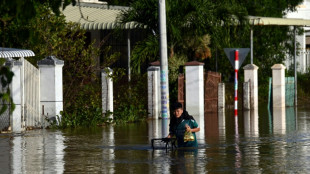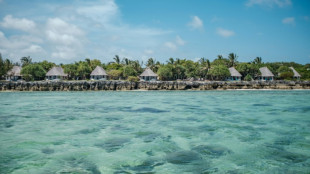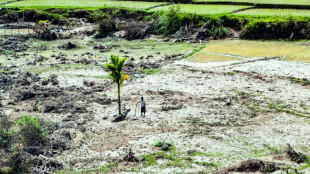
-
 Signing up to DR Congo peace is one thing, delivery another
Signing up to DR Congo peace is one thing, delivery another
-
'Amazing' figurines find in Egyptian tomb solves mystery

-
 Palestinians say Israeli army killed man in occupied West Bank
Palestinians say Israeli army killed man in occupied West Bank
-
McLaren will make 'practical' call on team orders in Abu Dhabi, says boss Brown

-
 Norris completes Abu Dhabi practice 'double top' to boost title bid
Norris completes Abu Dhabi practice 'double top' to boost title bid
-
Chiba leads Liu at skating's Grand Prix Final

-
 Meta partners with news outlets to expand AI content
Meta partners with news outlets to expand AI content
-
Mainoo 'being ruined' at Man Utd: Scholes

-
 Guardiola says broadcasters owe him wine after nine-goal thriller
Guardiola says broadcasters owe him wine after nine-goal thriller
-
Netflix to buy Warner Bros. Discovery in deal of the decade

-
 French stars Moefana and Atonio return for Champions Cup
French stars Moefana and Atonio return for Champions Cup
-
Penguins queue in Paris zoo for their bird flu jabs

-
 Netflix to buy Warner Bros. Discovery for nearly $83 billion
Netflix to buy Warner Bros. Discovery for nearly $83 billion
-
Sri Lanka issues fresh landslide warnings as toll nears 500

-
 Root says England still 'well and truly' in second Ashes Test
Root says England still 'well and truly' in second Ashes Test
-
Chelsea's Maresca says rotation unavoidable

-
 Italian president urges Olympic truce at Milan-Cortina torch ceremony
Italian president urges Olympic truce at Milan-Cortina torch ceremony
-
Norris edges Verstappen in opening practice for season-ending Abu Dhabi GP

-
 Australia race clear of England to seize control of second Ashes Test
Australia race clear of England to seize control of second Ashes Test
-
Trump strategy shifts from global role and vows 'resistance' in Europe

-
 Turkey orders arrest of 29 footballers in betting scandal
Turkey orders arrest of 29 footballers in betting scandal
-
EU hits X with 120-mn-euro fine, risking Trump ire

-
 Arsenal's Merino has earned striking role: Arteta
Arsenal's Merino has earned striking role: Arteta
-
Putin offers India 'uninterrupted' oil in summit talks with Modi

-
 New Trump strategy vows shift from global role to regional
New Trump strategy vows shift from global role to regional
-
World Athletics ditches long jump take-off zone reform

-
 French town offers 1,000-euro birth bonuses to save local clinic
French town offers 1,000-euro birth bonuses to save local clinic
-
After wins abroad, Syria leader must gain trust at home

-
 Slot spots 'positive' signs at struggling Liverpool
Slot spots 'positive' signs at struggling Liverpool
-
Eyes of football world on 2026 World Cup draw with Trump centre stage

-
 South Africa rugby coach Erasmus extends contract until 2031
South Africa rugby coach Erasmus extends contract until 2031
-
Ex-Manchester Utd star Lingard announces South Korea exit

-
 Australia edge ominously within 106 runs of England in second Ashes Test
Australia edge ominously within 106 runs of England in second Ashes Test
-
McIlroy survives as Min Woo Lee surges into Australian Open hunt

-
 German factory orders rise more than expected
German factory orders rise more than expected
-
Flooding kills two as Vietnam hit by dozens of landslides

-
 Italy to open Europe's first marine sanctuary for dolphins
Italy to open Europe's first marine sanctuary for dolphins
-
Hong Kong university suspends student union after calls for fire justice

-
 Asian markets rise ahead of US data, expected Fed rate cut
Asian markets rise ahead of US data, expected Fed rate cut
-
Nigerian nightlife finds a new extravagance: cabaret

-
 Tanzania tourism suffers after election killings
Tanzania tourism suffers after election killings
-
Yo-de-lay-UNESCO? Swiss hope for yodel heritage listing

-
 Weatherald fires up as Australia race to 130-1 in second Ashes Test
Weatherald fires up as Australia race to 130-1 in second Ashes Test
-
Georgia's street dogs stir affection, fear, national debate

-
 Survivors pick up pieces in flood-hit Indonesia as more rain predicted
Survivors pick up pieces in flood-hit Indonesia as more rain predicted
-
Gibbs runs for three TDs as Lions down Cowboys to boost NFL playoff bid

-
 Pandas and ping-pong: Macron ending China visit on lighter note
Pandas and ping-pong: Macron ending China visit on lighter note
-
TikTok to comply with 'upsetting' Australian under-16 ban

-
 Hope's resistance keeps West Indies alive in New Zealand Test
Hope's resistance keeps West Indies alive in New Zealand Test
-
Pentagon endorses Australia submarine pact


New microscopic organisms found in deep sea trench baffle Chile scientists
When Chilean scientist Osvaldo Ulloa led an expedition 8,000 meters under the sea to an area where no human had ever been, his team discovered microscopic organisms that generated more questions than answers.
The January submarine expedition dove into the Atacama Trench, created by the meeting of two tectonic plates in the eastern Pacific Ocean.
"We pulled off the feat of taking humans into the trench where no other human being had been before," Ulloa, the director of the Millennium Institute of Oceanography at the University of Concepcion, told AFP.
He was joined by American explorer Victor Vescovo and Millennium assistant director Ruben Escribano on the 12-week journey off Chile's northern coast in the 5,900-kilometer (3,650-mile) long trench that extends up to Ecuador.
By the time the expedition, named Atacama Hadal, reached a depth of 100 meters it was already in pitch black darkness, with the crew members' vision limited to what the submarine's powerful LED light could capture.
Further down out of the darkness emerged remarkable examples of deep sea life.
"We came across geological structures and there we saw a type of holothurians or translucent sea cucumbers, like jelly, that we had not recorded and were most probably new species," said Ulloa.
"We also discovered bacterial communities that had filaments that we did not even know existed in the Atacama Trench and which feed on chemical and inorganic compounds.
"That opened up a huge number of questions: What are those compounds? What type of bacteria are they? We have no idea, we're going to have to go back there."
The expedition also found species of amphipods, a type of crustacean closely related to shrimp, which were scavenging crustaceans, segmented worms and translucent fish. They were discovered in the same place in an unmanned expedition in 2018.
- 'Incredibly ambitious' –
The Atacama Trench -- also known as the Peru-Chile Trench -- lies where the Nazca and South American tectonic plates converge.
It is an area that has produced many earthquakes and tsunamis.
"We will put three sensors on the South American Plate and two on the Nazca Plate to see how the oceanic floor is deformed," said Ulloa.
For the moment, "these types of sensors only exist on land."
The devices will allow scientists to observe where energy is building in areas that have not had an earthquake, thus helping predict where the next temblor will take place.
"It is an incredibly ambitious project," said Ulloa, adding that it is "the largest experiment that has been done in underwater geology here in Chile."
The sensors are due to be placed during the second half of this year.
"There is a lot of interest from the international community to put more sensors in this region to study all the processes associated with the collision of these two plates."
B.Godinho--PC



